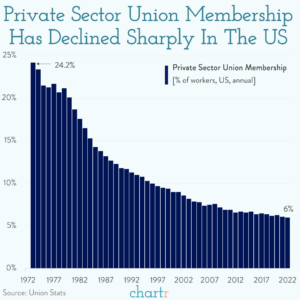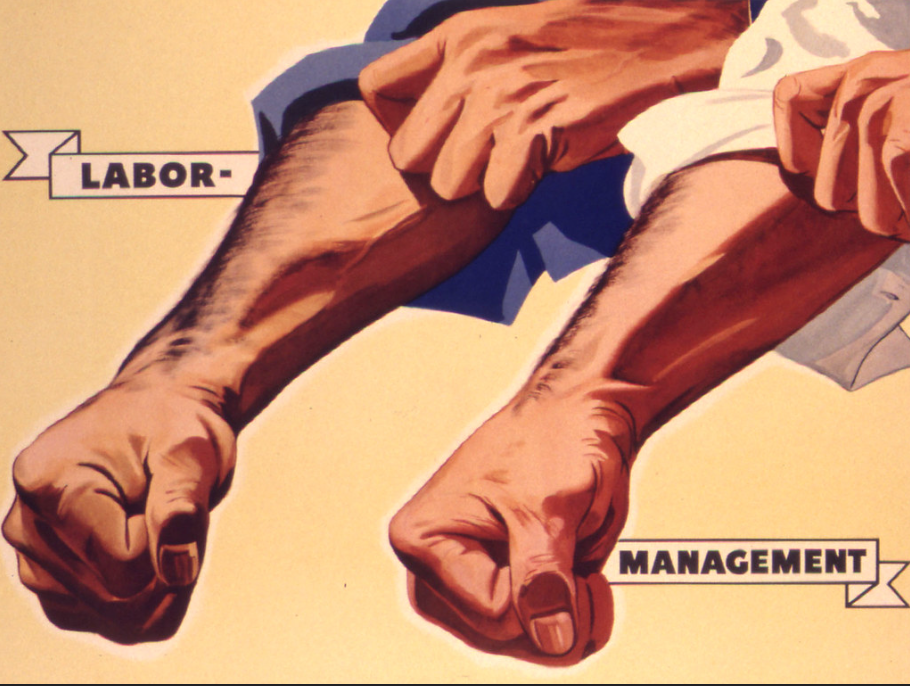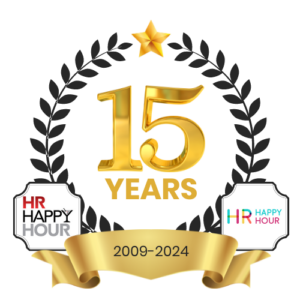Labor Market Focus: Labor Unions Had a Big 2023 but Face an Uncertain Future
February 6, 2024
Recent high-profile organized labor wins at odds with the overall decline in union membership – with implications for the labor market in 2024 and beyond.
By the mid-1950s, unions in the US had successfully organized approximately one out of every three non-farm workers. This period represented the height of organized labor’s power, as the numbers of unionized workers have shrunk in subsequent decades. The decline in union membership gathered pace in the 1980s and 1990s, driven by a combination of economic and political factors. The gradual opening of international markets increased competition for US companies in many highly organized industries. Additionally, labor and production outsourcing emerged as a popular strategy among employers seeking to compete in a changing and increasingly global environment. Other factors which impacted union organizing included the deregulation of domestic industries not threatened by overseas competition, such as trucking, also placed organized labor at a disadvantage as new firms which were not unionized gained market share through lower labor costs they could pass on to customers.
Additionally, many US companies developed a set of tactics and policies aimed at either eliminating unions where they were in place and preventing unions from gaining traction and a foothold in industries, regions, and companies where they were not present. The “anti-union” playbook typically included making veiled and even not-so-subtle threats to employees who were organizing or who were considered sympathetic to the union, holding mandatory all-worker meetings where anti-union messages were shared, and hiring permanent (non-union) replacement workers in the event of strikes or labor slowdowns. Many of these same tactics are in place and are utilized today by companies facing emerging unionization efforts.
Also during these years labor unions were constrained by a sharp political turn against them which further emboldened these employer efforts. President Reagan’s public firing of striking air traffic controllers in the 80s pointedly demonstrated to a reeling labor movement that times had changed. Many anti-union politicians repeatedly blocked all union-backed efforts to strengthen organized labor’s position, including in 2008-2009, with the successful Senate filibuster of the Employee Free Choice Act. The EFCA would have made private sector organization efforts somewhat easier by allowing a union to be certified as the official union to bargain with an employer if union officials collected the signatures of most of the workers. Additionally, the bill would have required employers and unions to enter binding arbitration to produce a collective agreement at least 120 days after a union is recognized – important to eliminate the stalling tactics many employers fall back on in negotiations. A few subsequent attempts at re-introducing the EFCA have not made progress as the proposals in the Act have generated sharp, partisan political disagreement.
In 2024, Some Union Successes Despite Overall Struggles
Fast-forward to the beginning of 2024, where the state of the organized labor movement can easily be described as conflicted. From a pure data and numbers perspective, the most recent report from the Bureau of Labor Statistics shows that the union membership rate is at an all-time low (see chart below). The BLS reports that at the start of the new year the share of US workers who are members of a union has declined to a new low of just 1 in 10 employees being unionized in 2023, slightly down from 10.1% the year before. And for private sector workers, the unionization rate is even lower – at about 6% of workers being represented by a union.

But despite these declines in the absolute numbers of union workers, and the low overall rate of union membership, 2023’s labor market news was full of high-profile and large-scale organized labor stories. And in many of the most-followed labor fights, unions (and their members), were able to make significant gains in wages, benefits, working conditions and more. Here are some of the most prominent labor wins in 2023:
United Auto Workers (UAW)
The UAW forced General Motors, Ford, and Stellantis, the “Big Three” US automakers, to scrap many of the multiple tiers of wages that the union had to accept in previous rounds of concessions to help bail out the industry. Representing about 150,000 workers, the union also won 11% pay increases in the first year of the 4.5-year agreement, and a 25% pay increase over the life of the contract.
The companies also awarded workers a $5,000 ratification bonus, agreed to raises for the lowest and highest-paid workers, and agreed in principle to bring new electric-vehicle battery plants into the national contract, giving the UAW an opportunity to organize them.
United Parcel Service (UPS)
Last summer, delivery giant United Parcel Service (UPS) averted a strike by 330,000 workers represented by the Teamsters Union by making significant concessions during tense negotiations. The contract includes meaningful pay increases over the next five years. Both full- and part-time UPS workers who are union members will get $2.75 more per hour in wages in 2023. New part-time hires at UPS will start at $21 per hour and advance to $23 per hour. Wage increases will reach $7.50 an hour over the length of the contract.
Additionally, Martin Luther King Jr Day was added to company holidays, the union successfully ended forced overtime on drivers’ days off, won the elimination of a two-tier wage system and scored important health and safety improvements, including air conditioning on more trucks.
Hollywood: SAG-AFTRA and the Writer’s Guild of America (WGA)
As arguably the most publicized union effort of the year, Hollywood saw two major strikes in 2023: the Writers Guild of America and SAG-AFTRA, or the performers (actors) union. After a 146-day or nearly five-month strike, the Writers Guild of America and major Hollywood studios reached an agreement.
The proposed three-year contract would increase pay by up to 12.5% and improve residual payments (by as much as 26%), for streaming shows. It would also generate new guidelines regarding the use of artificial intelligence. One of the main reasons the union’s 11,500 members went on strike was to protect themselves from streaming and other industry shifts that could threaten their careers and salaries.
Hollywood actors soon followed their counterparts in the Writer’s Guild. For the first time in 63 years, SAG-AFTRA members—or members of the Screen Actors Guild-American Federation of Television and Radio Artists—also went on strike. The nearly 160,000-member union fought for residual payments linked to their performance, citing issues with streaming platforms and artificial intelligence.
Strikes shut down several high-profile film and TV show productions but resulted in a more than one-billion-dollar deal (over a three-year period), that increased minimum payments to actors and their share of streaming revenue. Salary minimums for appearances in films and TV productions were increased and new protections against use of actor’s likenesses by AI technologies were enacted.
These four labor actions and the subsequent contracts that the various unions were able to complete on behalf of their members resulted in significant wage increases, benefits enhancements, job protections, and other benefits for union employees. Collectively, they indicate, or at least suggest, that the power balance scale between employer and employee may have shifted somewhat in favor of the employee. After all, these four contracts cover about 650,000 total employees, not an insignificant number in the labor force’s makeup.
Where Can Unions Go from Here?
In order to expand their influence, labor organizers are beginning to look for new industries and companies. Hard-to-organize service industries employ six times as many workers as manufacturing, mining and construction. And in manufacturing, new factories tend to be built in states more hostile to labor organizing efforts. Many of the country’s largest employers like Amazon, Walmart, and Starbucks are well-known for their active opposition to labor organizing in their employee ranks. But the sheer numbers of workers in these companies make the attempts at organization worth the risk for union leaders.
Some of organized labor’s success is likely attributable to the extended, post-pandemic tightening of the labor market where most industries and companies are facing notable difficulty in finding, attracting, retaining, and developing talent. The long-awaited upcoming recession that had been expected by many economists has failed to materialize, and despite plenty of high-profile reductions and layoffs (primarily in the technology sector), the war for talent remains pitched and challenging for most organizations.
But despite the several successes in 2023, and even absent a recession, organized labor still faces multiple headwinds. Most American employers are still staunchly anti-union, and labor’s recent gains, while important and large, are still representative of a relatively small segment of the overall American labor market and may not be predictive of future trends in management/labor relations. But amidst these challenges, for unions and their supporters, there are some encouraging signs. The share of workers represented by a labor union ticked up in the private sector in 2023, even though overall union membership fell to a new low. And successes like the UAW’s with the Big Three automakers have emboldened union activists to seek to extend the UAW’s influence in the numerous other auto manufacturing locations operated by companies like Mercedes, BMW, and Nissan.
Finally, the next generation of the workforce seems to be more supportive of unions and labor organizing than their more experienced counterparts are. In the past decade, people in their teens and 20s have been on the front lines of strikes and organizing drives across the country, for instance at Starbucks, Amazon and major universities from New York to California.
According to a report by the Center for American Progress, Gen Z is the most pro-union generation alive today. The report also states that Gen Zers are more supportive of unions than even older generations were at their age. This is evident from the fact that in 2020, Gen Zers had a mean approval rating of 64.3% for unions, compared to 60.5% for Millennials, 57.8% for Gen Xers, and 57.2% for Baby Boomers.
The report further highlights that Gen Zers have more progressive attitudes than older generations and are eager to organize and win union gains for themselves at workplaces nationwide. In summary, Gen Z is a pro-union generation that is eager to organize and win union gains for themselves at workplaces nationwide. But, with their comparatively less work experience than prior generations, it is arguable the most Gen Z workers fully comprehend the myriad of workplace and labor issues that combine and interact with external and environmental conditions and possess the expertise to make fully informed decisions on labor issues.
For HR and Organizational Leadership Encountering New Organizing Efforts
While most experts expect labor organizing to be a big part of the world of work once again this year, it is instructive to examine how organizations and leaders are responding to their workers and the worker’s representatives.
Over the past few years, we’ve seen major companies respond to unionization efforts in all kinds of ways, from Amazon taking disciplinary action against workers involved in a unionizing campaign at a Staten Island warehouse, to Starbucks agreeing to meet at the bargaining table with employees after two years of resistance.
Because many more workplaces are likely to organize soon due to a new National Labor Relations Board ruling that makes organizing logistically easier, it’s important that managers and HR leaders understand how to respond in the right way when their workers consider forming a union.
HR and communications experts generally feel that first and foremost, companies and managers should take the opportunity when employees are interested in unionizing to reflect on why this is happening. “This an opportunity to say: ‘What have we done, what have we not done that has led us to a point where our own employees feel like their only recourse to get us to listen is to organize?’” notes David Kryscynski, an associate professor of human resources at Rutgers University.
From then on, it’s important to gather important stakeholders in one room to make sure management is communicating clearly, being transparent with employees, and trying to emphasize real-life conversations over digital barbs and petulant messages.
But it’s equally important to know how management should avoid responding to a union drive. That includes not taking it personally, staying away from any kind of reactionary messaging, and ditching any kind of token gestures intended to placate workers without a thorough follow-through.
Perhaps it is most important for managers, HR leaders, and business owners to remember that employees and their representatives are not interested in destroying companies. Employees want to be treated fairly, they want to be treated respectfully, and they want to be able to live happy lives and be healthy at work. When employees organize and advocate for better pay, benefits, working conditions, etc., it is not to put the company out of operations, but rather to create a better environment where organizations can succeed, and employees can be treated more like true partners and participants in that success.
As labor organizing is expected to grow even more broadly in 2024, these are important issues for leaders everywhere.
Conclusion
The prospects for labor unions in the US in 2024 are largely mixed. According to a report by Marketplace, labor unions had notable successes in 2023 in part because workers were frustrated coming out of the early years of the pandemic, and in many frontline and in-person workplaces had felt the tremendous strain of having to “show up” for work in often uncertain and even scary circumstances. Then, high-profile contract negotiations at the UAW and in Hollywood also elevated the issues that are of concern to organized labor and workers and helped make labor issues more visible and top-of-mind in 2023 – buoyed by the highest level of public support for labor unions in decades. However, it is unclear whether labor unions will maintain their momentum in 2024.
On the one hand, if the job market and the overall economy remain strong throughout 2024, union negotiators will be able to ask for more generous contracts. But if things slow down, and the job reductions and cost cutting we are seeing in the technology and media industries become more widespread in the labor market, then it will be very difficult for labor unions to demand more in terms of compensation, benefits, and improved working arrangements.
In the even larger picture, all these labor negotiations are happening in a changing demographic environment. The US Bureau of Labor Statistics projects that the labor force is expected to grow only slightly, reaching 163.8 million in 2024. The impacts of a declining labor force participation rate, an aging population, and record-low birth rates are all expected to contribute to a slower rate of labor force growth in the future. With fewer available, trained, and willing workers, it could be argued that labor unions’ position will continue to strengthen, as more companies feel the pinch of competition for talent. It will be extremely interesting to see how the rest of the year and decade play out, as Labor vs. Management will certainly be one of the most compelling and important world of work stories for some time to come.

Author
Categories
Tags
Share
How we can help
Led by Trish Steed and Steve Boese, H3 HR Advisors harnesses over 40 years of experience to delivery HCM insights and guidance to global organizations.
H3 HR Advisory services
By leveraging technology, analytics, and our deep industry knowledge we can help you to reposition your workforce and ensure that you have the right people with the right capabilities in the right roles to positively impact the growth of your business.
HR Happy Hour Podcast Network
Created in 2009, The HR Happy Hour Show is hosted by Steve Boese and Trish Steed and is the longest continuously running internet radio show and podcast on Human Resources, HR Technology, Talent Practices, Workplace and Leadership topics.
H3 HR Speaking Services
We work closely with every client to customize your content - keynotes, webinars, research, infographics, and buyer’s guides - to inspire, educate and inform the audience enabling you to reset and realign your organization for a talent-led breakthrough.
Get in touch
Talk to us today and find out how we can help you and your organization leverage HCM technology to attract, onboard, retain and manage top talent.



